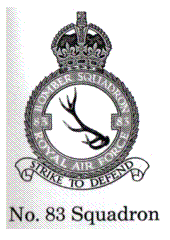 |
No 83 Squadron
 |
Here is another most unusual badge design with an interesting story behind its adoption. The antler of a red deer is shown for No. 83 Squadron and commemorates the fact that this unit was originally formed at Montrose in Scotland. But there is more to the design than this, for the attire has six points and this number is significant. It recalls the fact that on the night of 14-15 June, 1918, when bad weather conditions had grounded every other Allied aircraft on the Western Front , three of No.83 Squadron's aircraft, all two-seaters and thus with a total crew complement of six, managed to get airborne over a vital sector of the front-line and make a reconnaissance. Further symbolisation is in the fact that the antler is back, which is associated with the fact that No. 83 flew numerous night missions, while the three points at the head of the attire symbolise the crown of success which attended so many of No. 83 Squadron's sorties. This rather complex background story results in a pleasing and simple design for the badge granted to the squadron in April, 1938, by King George VI. The motto of the squadron is "Strike to Defend".
Formed as No. 83 Squadron, R.F.C on 7th January , 1917, this unit was located at Montrose as a night-bombing squadron went over to France on 4th March, 1918 and fought for the next eight months in a night bomber and night reconnaissance role. No. 83 Squadron returned to England , and with the subsequent post-war run down it was reduced to a cadre from March, 1919, until the 31st December, 1919, when it was completely disbanded.
It was not until 4th August, 1936, that No. 83 Squadron was re-formed, again as a bomber squadron at Turnhouse, Midlothian, in Scotland once more. No. 83 was initially equipped with the Hawker Hind, which aircraft it retained until December , 1938.
The squadron was re-equipped with the Handley Page Hampden in November, 1938, and was serving with this monoplane bomber at the outbreak of war. It flew its first operational mission on the 3rd September , 1939, when six Hampdens flew over the North Sea on an armed reconnaissance . The usual frustrating months of missions armed with nothing more lethal than leaflets followed and it was not until April, 1940, that No. 83 started flying more aggressive sorties, the first being a series of minelaying operations, a regular feature of Hampden activity during the ensuing months. With the fall of all our allies in a two month campaign, No.83 Squadron was soon fully extended . In August , 1940, an attack was made on the Dortmund-Ems Canal in company with No.49 Squadron. Among the other targets allocated to the squadron during this period was Berlin itself.
A notable event was the winning of the squadron's Victoria Cross in September, 1940. During an attack on the assembled German invasion barges at Antwerp on the night of the 15-16 September, Flight Sergeant John Hannah was the wireless operator-air gunner of one of No.83 Squadron's Hampdens whith was hit and set on fire by heavy flak over the target area. The fire ignited the bomb compartment and threatened to spread, fuelled by the piercing of two petrol tanks. Despite the intense head and exploding ammunition Hannah fought the fire, in the last stages with his log book, and succeeded in putting out the flames.

In March , 1942, the squadron was re-equipped with the new bombers, the Avro Manchester B.I and B.I a at Scampton. With this aircraft No.83 Squadron contributed to the devastating raids on Cologne and Essen and also dropped its first 4,000 Ib bombs over the Reich. Despite this the Manchester was soon replaced by the Avro Lancaster, No.83 Squadron being equipped with this outstanding machine in May, 1942, and continued to operate it throughout the remaining years of the war
Between August, 1942, and April, 1944, No.83 Squadron used Wyton No.83 joined the elite Pathfinder Force, the above-average units from the enormously expanded bomber arm, who led the way to the targets for the main bomber streams. The first such attack in which aircraft of No83 Squadron participated was against Flensburg on the night of the 19th August, 1942. Other targets included some in northern Italy, a round trip of almost 1,500 miles. In 1943 No.83 Squadron was involved in the bloody battles over Berlin, Hamburg and the Ruhr. On the night of the 17-18 August, 1943, No.83 Squadron was part of the force which hit the German rocket base at Peenemunde with such devastating effect.
Transferring from No.8 Group back to No.83 was involved in the softening-up process preceding the invasion of France in June , 1944, and the unit's final mission was against oil installations in Norway. The squadron then prepared for a move to the east to participate in Operation "Olympic", the proposed invasion of Japan, but with the dropping of the first two atomic bombs the war ended early.
In July,1946, the squadron re-equipped with the Avro Lincolns and in October moved to Hemswell, Lincolnshire. During the next nine years No.83 Squadron remained in service with aircraft, including bombing missions against the communists in Malaya. The squadron was disbanded in December, 1955.
In 1957 however the squadron was re-activated, and under the identification of "Antler" Squadron was the first to be equipped with the new delta-wing Avro Vulcan B.I at Waddington , Lincolnshire, for three years and, from October, 1960, at Scampton. No.83 Squadron was the second fully operational Vulcan squadron to be armed with the deadly "Blue Steel" stand-off bomb.
A month after their formation the squadron won both the Lawrence Minot Trophy and the Sir Philip Sassoon Cup, while one crew won the individual Crew Bombing Navigation Trophy and the Individual Crew Navigation Trophy, thus gaining four prizes out of a possible six. No.83 Squadron was finally disbanded at Scampton on 31st August, 1969.